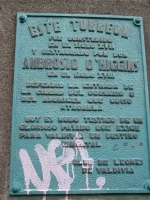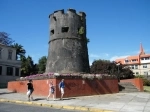The towers Picarte and Canelos in Valdivia. Valdivia - CHILE
The towers Picarte The Canelos and are the only vestiges that remain in the bottom of the fortifications of Valdivia. The city, founded in 1552 by Pedro de Valdivia, was razed by the Indian uprising occurred in the late sixteenth century. During the seventeenth century, the Viceroy Antonio de Toledo of Peru, sent an army equipped with a contingent of 900 men, stores and a large amount of building materials, to meet two objectives: to recreate the city of Valdivia and establish fortifications in the area, particularly in the mouth of the river of that name. These goals were a high priority for the Spanish Crown, under the strategic nature of the place. It was necessary to maintain imperial sovereignty well defended this coastal area exposed to the ambitions of rival powers (England, Holland, France), who had already dabbled in it through various expeditions.
The management of Viceroy Toledo led to the biggest stronghold of the American Pacific coast, formed by a group of fortifications among which include the forts of Corral and Niebla, the Castle of San Luis de Alba and San Pedro of bitters, among others. With respect to Valdivia, in addition to reshape this city, the army sent by the Viceroy proceeded to fortify it as well, giving it fatigues and ground defenses that later would be replaced by stone walls. It is however in the eighteenth century when the Valdivia defense plan reaches full implementation, under a comprehensive plan developed by engineer John Garland. An important part of this plan was the construction of two towers, the Governor of the square Joaquin Espinoza executed in 1774 under the threat posed by European rivals not so much as the natives of the place.
The towers Picarte and Los Canelos (formerly called "The Mud") are cylindrical in shape and were built with brick and mortar, the walls have a thickness of 60 cm at its base and 30 inches at the top. The structures were designed to serve as a lookout or lookouts, however, they are also used as dungeons, powder magazines and windmills. The construction of these defenses was very frustrating for Espinoza, who was questioned by the alleged uselessness of these structures.


